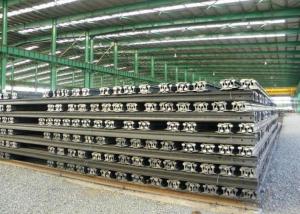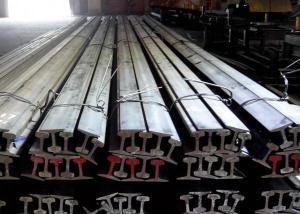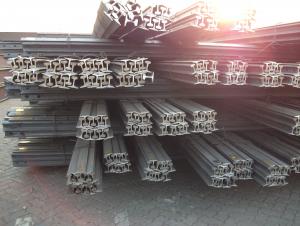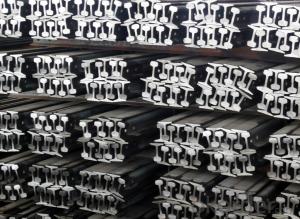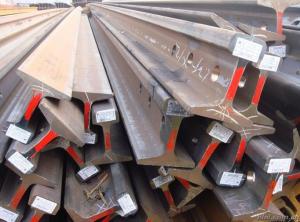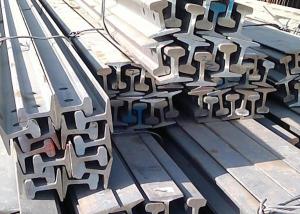Steel Heavy Rail with High Quality for Construction
- Loading Port:
- China main port
- Payment Terms:
- TT or LC
- Min Order Qty:
- 25 m.t.
- Supply Capability:
- 100000 m.t./month
OKorder Service Pledge
OKorder Financial Service
You Might Also Like
Product Description of Steel Heavy Rail with High Quality for Construction:
Sizes: 38kg, 43kg, 45kg, 50kg, 60kg.
Production Standard: GB2585-81, DIN, AREMA, JIS, BS, UIC, etc.
Material: 50MN, U71MN, 900A, 110A, etc.
Length: 6m-25m according to the requriements of the clients
Usages of Steel Heavy Rail with High Quality for Construction:
Light rail is mainly used in forest region, mines, factories and construction sites laid of the place such as temporary transport line and light motorcycles with line. Be widely used for railway, subway, transportation track, express, curve way, tunnel way and so on.
Packaging & Delivery of Steel Heavy Rail with High Quality for Construction:
1. Packing: it is nude packed in bundles by steel wire rod
2. Bundle weight: not more than 3.5MT for bulk vessel; less than 3 MT for container load
3. Marks:
Color marking: There will be color marking on both end of the bundle for the cargo delivered by bulk vessel. That makes it easily to distinguish at the destination port.
Tag mark: there will be tag mark tied up on the bundles. The information usually including supplier logo and name, product name, made in China, shipping marks and other information request by the customer.
If loading by container the marking is not needed, but we will prepare it as customer request.
4. Transportation: the goods are delivered by truck from mill to loading port, the maximum quantity can be loaded is around 40MTs by each truck. If the order quantity cannot reach the full truck loaded, the transportation cost per ton will be little higher than full load.
5. Delivered by container or bulk vessel
6. Delivery Time: All the Hot Rolled Steel Rail will be transpoted at the port of Tianjin, China within 30 days after receiving the advance payment by T/T or the orginal L/C at sight.
Inspection of Steel Heavy Rail with High Quality for Construction:
We will send the MTC of the factory to the clients dirrectly which contain the anlisis of the heat, chemiqul composition, phisical characteristicas, etc.
And our inspectors will arrive at the factory to meke the inspection of the size, length, weight and quantity before the transportation from the factory.
FAQ:
Q1: Why buy Materials & Equipment from OKorder.com?
A1: All products offered byOKorder.com are carefully selected from China's most reliable manufacturing enterprises. Through its ISO certifications, OKorder.com adheres to the highest standards and a commitment to supply chain safety and customer satisfaction.
Q2: How do we guarantee the quality of our products?
A2: We have established an advanced quality management system which conducts strict quality tests at every step, from raw materials to the final product. At the same time, we provide extensive follow-up service assurances as required.
Q3: How soon can we receive the product after purchase?
A3: Within three days of placing an order, we will begin production. The specific shipping date is dependent upon international and government factors, but is typically 7 to 10 workdays
Images:
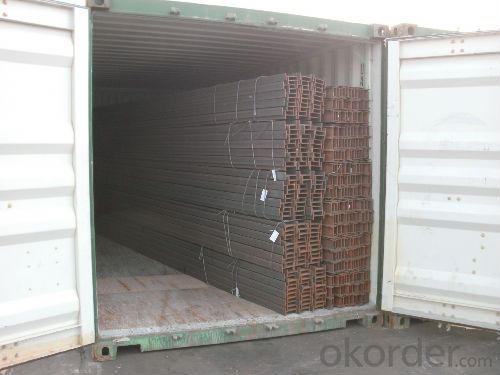
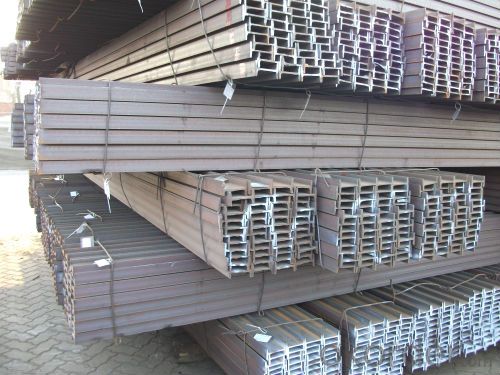
- Q:What are the different types of fastening systems used with steel rails?
- Steel rails in railroad infrastructure utilize various types of fastening systems, each serving a vital role in ensuring the secure attachment of rails to sleepers or ties, thereby guaranteeing stability and safety for train operations. 1. Rail clips: Widely employed in railway tracks, rail clips effectively fasten steel rails. Constructed from durable materials like steel, these clips possess a design that tightly grips the rail, preventing any lateral movement. Rail clips are typically used in conjunction with base plates and bolts. 2. Elastic fastenings: Also referred to as resilient fastenings, these are engineered to absorb dynamic forces exerted on rails as trains pass. Comprising rubber pads or springs placed between the rail and sleeper, they diminish noise and vibrations while providing flexibility to accommodate rail temperature fluctuations. 3. Pandrol fastenings: Pandrol fastenings, a widely utilized elastic fastening system worldwide, consist of clips, pads, and insulators that offer secure fastening with some flexibility. These fastenings are esteemed for their durability, ease of installation, and ability to minimize noise and vibration. 4. Bolted fastenings: Bolted fastenings entail the use of bolts, nuts, and washers to secure rails to sleepers. These fastenings are commonly utilized alongside base plates and rail pads. Bolted fastenings establish a robust and dependable connection between the rail and sleeper, ensuring stability and longevity. 5. Welded fastenings: Occasionally, steel rails are directly welded to sleepers or other steel components within the track system. Welded fastenings provide a permanent and secure connection, eliminating the need for supplementary fastening systems. High-speed rail systems and applications necessitating maximum stability and strength often employ welded fastenings. In summary, the assortment of fastening systems employed with steel rails offer numerous advantages in terms of stability, durability, flexibility, and noise reduction. The selection of a fastening system relies on factors such as the specific railway application, track conditions, and desired performance requirements.
- Q:Can steel rails be used in railway systems with heavy rainfall?
- Yes, steel rails can be used in railway systems with heavy rainfall. Steel is a highly durable and corrosion-resistant material, making it suitable for use in environments with high levels of moisture. However, proper maintenance and preventive measures should be taken to ensure the longevity and performance of steel rails in heavy rainfall areas. Regular inspections, cleaning, and protective coatings can help minimize the potential for corrosion and ensure the safe and efficient operation of the railway system.
- Q:How are steel rails protected against electromagnetic interference?
- Steel rails are protected against electromagnetic interference through various methods. One common approach is to use an insulating coating on the rails, which helps to minimize the impact of electromagnetic fields. Additionally, the use of grounding techniques and shielding materials can further reduce the effects of electromagnetic interference on the rails. These measures help to maintain the integrity and functionality of the rail system, ensuring safe and efficient transportation.
- Q:How do steel rails contribute to train derailment prevention?
- The prevention of train derailments is heavily reliant on the utilization of steel rails, which serve as a secure and dependable track foundation. Here are several ways in which steel rails contribute to the prevention of derailments: 1. Strength and durability: Steel rails possess the necessary design features to endure substantial loads and continuous wear and tear. Their exceptional tensile strength guarantees the ability to bear the weight of trains, thereby averting any bending or fracturing under pressure. This durability significantly diminishes the likelihood of rail failures that may result in derailments. 2. Track alignment: Steel rails are meticulously crafted to maintain precise track alignment. The rails are manufactured to be straight and parallel, ensuring that train wheels remain on the track. Deviations in alignment can lead to derailments. By maintaining accurate track alignment, steel rails effectively minimize the risk of derailments arising from track irregularities. 3. Resistance to deformation: Steel rails exhibit a remarkable resistance to deformation, enabling them to endure heavy loads without significant bending or warping. This resistance to deformation plays a pivotal role in preventing derailments, as it aids in preserving the shape and stability of the track. Even in extreme temperatures, steel rails are less likely to expand or contract, thereby reducing the risk of derailments caused by track distortion. 4. Regular maintenance: The integrity and safety of steel rails necessitate regular inspection and maintenance. Through routine procedures such as track inspections, rail grinding, and the replacement of worn-out rails, potential issues like rail cracks, worn joints, or loose fasteners can be promptly identified and addressed. This proactive approach to maintenance effectively prevents derailments by ensuring the track remains in optimal condition. 5. Weight distribution: Steel rails effectively distribute the weight of trains evenly, thereby minimizing stress on individual sections of the track. This mitigates excessive wear and tear on specific areas, consequently reducing the risk of rail failure and derailments. By uniformly distributing the load, steel rails significantly contribute to the overall stability and safety of the track. In conclusion, steel rails play an indispensable role in preventing train derailments by virtue of their strength, durability, accurate alignment, resistance to deformation, and even weight distribution. Regular maintenance and inspections also aid in identifying potential issues and ensuring the track remains safe for train operations.
- Q:How do steel rails contribute to train noise reduction?
- There are several ways in which steel rails contribute to the reduction of train noise. Firstly, the smooth and continuous design of steel rails aids in minimizing the impact of wheels on the tracks, thereby reducing vibrations and subsequent noise. Moreover, steel rails are securely fastened to the track bed, ensuring stability and minimizing any potential rattling or shaking that may generate noise. Additionally, steel rails are often treated with various materials or coatings that absorb sound and vibrations, further decreasing noise levels. Finally, the use of steel rails allows for better control and alignment of the train, limiting unnecessary movements or disturbances that could cause increased noise. In conclusion, the design and construction of steel rails play a vital role in decreasing train noise, resulting in a more enjoyable and quieter experience for passengers and nearby residents.
- Q:Can steel rails be used in areas with high salinity?
- Yes, steel rails can be used in areas with high salinity. However, it is important to take certain precautions and use appropriate corrosion-resistant coatings on the steel rails to prevent damage and degradation caused by the corrosive effects of saltwater. Regular maintenance and inspections are also necessary to ensure the longevity and safe operation of the rail infrastructure in such areas.
- Q:What are the advantages of using steel rails in airport runways?
- There are several advantages of using steel rails in airport runways. Firstly, steel rails provide a smooth and stable surface, offering enhanced traction and reducing the risk of skidding during aircraft landings and takeoffs. Secondly, steel rails have a high load-bearing capacity, allowing them to support heavy aircraft without deformation or damage. Additionally, steel rails are resistant to wear and tear, ensuring durability and longevity even under heavy traffic conditions. Moreover, steel rails are easy to maintain, requiring minimal repairs and offering cost-effectiveness in the long run. Lastly, steel rails provide excellent visibility in low-light conditions, thanks to their reflective properties, which enhance safety during night operations. Overall, the use of steel rails in airport runways ensures efficient and safe aircraft movements, making them a preferred choice for many airports worldwide.
- Q:Can steel rails be used in high-rise construction projects?
- Yes, steel rails can be used in high-rise construction projects. Steel rails are commonly used as structural elements in the construction of high-rise buildings, particularly for providing support and stability to the building's framework. They are often used as beams, columns, or as part of the building's foundation system. The high strength and durability of steel rails make them a suitable choice for withstanding the load and stresses associated with large-scale construction projects.
- Q:How are steel rails protected from landslides?
- Steel rails are protected from landslides through various measures to ensure the safety and stability of railway tracks. One common method is the construction of retaining walls along the track alignment. These walls are typically made of concrete or other sturdy materials and are designed to prevent soil or debris from sliding onto the rails. Another approach is the use of slope stabilization techniques, such as installing rock bolts or soil nails into unstable slopes. These measures help to reinforce the ground and prevent it from shifting or sliding during landslides. Additionally, the use of geotextiles, which are synthetic materials that promote soil stability, can be applied to reinforce the embankments and prevent erosion. Regular inspection and maintenance of the railway infrastructure are also crucial in preventing landslides. Monitoring systems, such as inclinometers and ground-penetrating radar, can be employed to detect any signs of slope movement in advance. This allows for timely mitigation measures to be taken, such as slope reinforcement or diversion of water flow to prevent saturation of the soil. Furthermore, proper drainage systems are essential to prevent excessive water accumulation, which can weaken the ground and trigger landslides. This includes the installation of culverts, ditches, and gutters to ensure the efficient flow of water away from the railway tracks. Overall, a combination of engineering techniques, regular maintenance, and effective monitoring systems is employed to protect steel rails from landslides. These measures aim to enhance the stability and resilience of the railway infrastructure, ensuring the safe and uninterrupted operation of trains.
- Q:What are the safety measures taken for pedestrians near steel rail tracks?
- Safety measures taken for pedestrians near steel rail tracks include the following: 1. Pedestrian crossings: Pedestrian crossings are marked and designated at appropriate locations near rail tracks. These crossings are often equipped with warning signs, road markings, and sometimes, pedestrian signals to ensure that pedestrians can safely cross the tracks. 2. Railway gates/barriers: At certain high-risk areas, railway gates or barriers are installed to prevent pedestrians from accessing the tracks when trains are approaching. These gates are usually automated and are triggered by the presence of an approaching train. 3. Warning signs and signals: Various warning signs and signals are placed near rail tracks to alert pedestrians of the potential danger. These signs may include messages such as "Railroad Crossing" or "Look Both Ways Before Crossing" to encourage pedestrians to be cautious. 4. Safety education and awareness campaigns: Local transportation authorities often conduct safety education campaigns to raise awareness among pedestrians about the risks associated with rail tracks. These campaigns provide information on safe crossing techniques, the importance of paying attention to warning signs, and the consequences of trespassing on railway property. 5. Fencing and barriers: Fencing and barriers are installed along the railway tracks to prevent pedestrians from accessing the tracks at unauthorized locations. These physical barriers help to deter pedestrians from walking on or near the tracks, reducing the risk of accidents. 6. Speed restrictions: Speed restrictions are enforced on trains passing through areas with high pedestrian activity. This helps to minimize the chances of accidents, as slower-moving trains are more likely to stop in time in case of an emergency or an unexpected pedestrian presence. 7. Regular maintenance and inspection: Railway authorities regularly inspect and maintain the rail tracks to ensure that they are in good condition and free from any hazards that could pose a risk to pedestrians. This includes checking for loose or damaged rails, repairing any defects, and removing any debris near the tracks. Overall, safety measures for pedestrians near steel rail tracks aim to prevent accidents and promote the safe movement of pedestrians in close proximity to rail infrastructure. By implementing these measures, the risk of pedestrian accidents and injuries can be significantly reduced.
1. Manufacturer Overview |
|
|---|---|
| Location | |
| Year Established | |
| Annual Output Value | |
| Main Markets | |
| Company Certifications | |
2. Manufacturer Certificates |
|
|---|---|
| a) Certification Name | |
| Range | |
| Reference | |
| Validity Period | |
3. Manufacturer Capability |
|
|---|---|
| a)Trade Capacity | |
| Nearest Port | |
| Export Percentage | |
| No.of Employees in Trade Department | |
| Language Spoken: | |
| b)Factory Information | |
| Factory Size: | |
| No. of Production Lines | |
| Contract Manufacturing | |
| Product Price Range | |
Send your message to us
Steel Heavy Rail with High Quality for Construction
- Loading Port:
- China main port
- Payment Terms:
- TT or LC
- Min Order Qty:
- 25 m.t.
- Supply Capability:
- 100000 m.t./month
OKorder Service Pledge
OKorder Financial Service
Similar products
New products
Hot products
Related keywords




